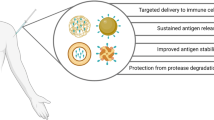No Heading
Purpose.
To evaluate the delivery of a novel HIV-1 antigen (gp120dV2 SF162) by surface adsorption or encapsulation within polylactide-co-glycolide microparticles and to compare both the formulations for their ability to preserve functional activity as measured by binding to soluble CD4.
Methods.
Poly(lactide-co-glycolide) microparticles were synthesized by a water-in-oil-in-water (w/o/w) emulsification method in the presence of the anionic surfactant dioctylsulfosuccinate (DSS) or polyvinyl alcohol. The HIV envelope glyocoprotein was adsorbed and encapsulated in the PLG particles. Binding efficiency and burst release measured to determine adsorption characteristics. The ability to bind CD4 was assayed to measure the functional integrity of gp120dV2 following different formulation processes.
Results.
Protein (antigen) binding to PLG microparticles was influenced by both electrostatic interaction and other mechanisms such as hydrophobic attraction and structural accommodation of the polymer and biomolecule. The functional activity as measured by the ability of gp120dV2 to bind CD4 was maintained by adsorption onto anionic microparticles but drastically reduced by encapsulation.
Conclusions.
The antigen on the adsorbed PLG formulation maintained its binding ability to soluble CD4 in comparison to encapsulation, demonstrating the feasibility of using these novel anionic microparticles as a potential vaccine delivery system.
Similar content being viewed by others
References
1. E. A. Emini and W. C. Koff. Developing an AIDS vaccine: need, uncertainty, hope. Science 304:1913–1914 (2004).
2. D. A. Garber, G. Silvestri, and M. B. Feinberg. Prospects for an AIDS vaccine: three big questions, no easy answers. Lancet Infect. Dis. 4:397–413 (2004).
3. S. C. Sookoian. New therapies on the horizon for hepatitis C. Ann Hepatol. 2:164–170 (2003).
4. S. E. Frey. HIV vaccines. Infectious Disease Clin. North America 13:95–112 (1999).
5. J. Esparza. An HIV vaccine: how and when? Bull. World Health Organ. 79:1093 (2001).
6. J. L. Cleland, M. F. Powell, A. Lim, L. Barron, P. W. Berman, D. J. Eastman, J. H. Nunberg, T. Wrin, and J. C. Vennari. Decelopment of a Single-Shot Subunit Vaccine for HIV-1. AIDS Res. Hum. Retroviruses 10(Suppl 2):21–26 (1994).
7. J. L. Cleland. Design and production of single-immunization vaccines using polylactide polyglycolide microsphere systems. Pharm. Biotechnol. 6:439–462 (1995).
8. D. O’Hagan, M. Singh, M. Ugozzoli, C. Wild, S. Barnett, M. Chen, M. Schaefer, B. Doe, G. Otten, and J Ulmer. Induction of potent immune responses by cationic microparticles with adsorbed human immunodeficiency virus DNA vaccines. J. Virol. 75:9037–9043 (2001).
9. J. Kazzaz, J. Neidleman, M. Singh, G. Ott, and D. T. O’Hagan. Novel anionic microparticles are a potent adjuvant for the induction of cytotoxic T lymphocytes against recombinant p55 gag from HIV-1. J. Controlled Release 67:347–356 (2000).
10. D. T. O’Hagan, M. Singh, J. Kazzaz, M. Briones, and J. Donnelly. and Ott, G. Synergistic adjuvant activity of immunostimulatory DNA and oil/water emulsions for immunization with HIV p55 gag antigen. Vaccine 20:3389–3398 (2002).
11. VaxGen. VaxGen announces initial results of its Phase III AIDS vaccine trial. Press release Feb 24, 2003 Available at http://www.vaxgen.com/pressroom/index.html.
12. R. E. Johnson, L. A. Lanaski, V. Gupta, M. J. Griffin, H. T. Gaud, T. E. Needham, and H. Zia. Stability of atriopeptin III in poly (lactide-co-glycolide) microparticles. J. Controll. Rel. 17:61 (1991).
13. B. Bittner, M. Morlock, H. Koll, G. Winter, and T. Kissel. Recombinant human erythropoietin (rhEPO) loaded poly(lactide-co-glycolide) microspheres: influence of the encapsulation technique and polymer purity on microsphere characteriztics. Eur. J. Pharm. Biopharm. 45:295–305 (1998).
14. R. Wyatt, P. D. Kwong, E. Desjardins, R. W. Sweet, J. Robinson, W. A. Hendrickson, and J. G. Sodroski. The antigenic structure of the HIV gp120 envelope glycoprotein. Nature 393:705–711 (1998).
15. P. D. Kwong, R. Wyatt, J. Robinson, R. W. Sweet, J. Sodroski, and W. A. Hendrickson. Structure of an HIV gp120 envelope glycoprotein in complex with the CD4 receptor and a neutralizing human antibody. Nature 393:648–659 (1998).
16. M. Singh and J. Kazzaz. Anionic microparticles are a potent delivery system for recombinant antigens from Neisseria meningitidis serotype B. J. Pharm. Sci. Vol. 93(2):273–282 (2004).
17. D. T. O’Hagan. The prospects for the development of new and improved vaccines through the use of microencapsulation technology. In M. M. Levine, G. C. Woodrow, J. B. Kaper, and G. S. Cobon (Eds.), New Generation Vaccines, Second Ed., Marcel Dekker, New York, pp. 215–228 (1997).
18. A. Martin. Physical Pharmacy, 4th ed., Lea and Febiger, Philadelphia, 1993.
19. S. J. Seeber, J. L. White, and S. L. Hem. Predicting the adsorption of proteins and aluminum-containing adjuvants. Vaccine 9:201–203 (1991).
20. P. M. Callahan, A. L. Shorter, and S. L. Hem. The importance of surface charge in the optimization of antigen-adjuvant interactions. Pharm. Res. 8:851–857 (1991).
21. M. F. Chang and S. L. Hem. Role of the electrostatic attractive force in the the adsorption of proteins by aluminum hydroxide adjuvant. PDA J. Pharm. Sci. Technol. 51:1–5 (1997).
Author information
Authors and Affiliations
Corresponding author
Rights and permissions
About this article
Cite this article
Singh, M., Chesko, J., Kazzaz, J. et al. Adsorption of a Novel Recombinant Glycoprotein from HIV (Env gp120dV2 SF162) to Anionic PLG Microparticles Retains the Structural Integrity of the Protein, Whereas Encapsulation in PLG Microparticles Does Not. Pharm Res 21, 2148–2152 (2004). https://doi.org/10.1007/s11095-004-7666-6
Received:
Accepted:
Published:
Issue Date:
DOI: https://doi.org/10.1007/s11095-004-7666-6




